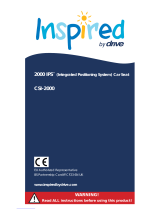
2 3
Section TitleSection Title
• Harness mode: use only with children who weigh between 25
and 85 lbs (11.4 and 38.6 kg) and whose height is between 30
and 57 in. (76.2 and 144.8 cm) and are at least 2 years of age.
• Booster mode: use only with children who weigh between 40
and 120 lbs (18.2 and 54.5 kg) and whose height is between
42 and 65 in. (106.7 and 165.1 cm).
• Snugly adjust the belts provided with this child restraint around
your child.
• Secure the top anchorage strap provided with this child seat.
• Use only the vehicle’s lap and shoulder belt system when
restraining the child in this booster seat.
• Secure this child restraint with the vehicle’s child restraint
anchorage system if available or with a vehicle belt.
• Follow all instructions on this child restraint and in the written
instructions located in the pocket behind the cover of the child
seat.
• Register your child restraint with the manufacturer.
• For harness mode refer to your vehicle owner’s manual or
contact the vehicle manufacturer for the maximum weight
rating for the LATCH anchors in your vehicle. Use the vehicle
belt (not LATCH connectors) for installations with children
who weigh more than the vehicle LATCH anchor limit. Unless
specified otherwise by the vehicle manufacturer, assume a 40
pound (18.2 kg) child is the vehicle LATCH anchor limit.
• Use this child seat forward-facing only.
• According to accident statistics, children are safer when
properly restrained in the rear seating positions than in the front
seating positions.
• This child seat must not be used in the home, in boats, or other
non-certified applications.
• To prevent injury due to deterioration or hidden damage,
discontinue use of this child seat when it is older than nine
years or has been in a moderate or severe crash. See date of
manufacture and expiration date located on child seat shell.
See page 6.
• The primary protection for occupants of a vehicle in a collision
is the body of the vehicle itself. A child seat may not protect a
child when the vehicle is seriously im pact ed. However when
correctly installed, a child seat will substantially improve the
chances for survival in most crashes.
• Cover the child seat when the vehicle is parked in direct
sunlight. Parts of the child seat can become hot enough to
burn a child.
• Secure this child seat even when it is not occupied. In a crash,
an unsecured child seat may injure vehicle occupants.
• Store the child seat in a safe place when it is not being used.
Avoid placing heavy objects on top of the child seat.
• Never use the harness or adjuster strap to lift or carry this child
seat. Doing so could damage the harness adjuster and webbing.
Always carry this child seat by the shell or tether straps.
• Do not allow children to play with this child seat.
• The use of non-Britax covers, inserts, toys, accessories, or
tightening devices is not approved by Britax. Their use could
cause this child seat to fail Federal Motor Vehicle Safety
Standards or not perform as intended in a crash.
• Always check the back seat upon leaving your vehicle to prevent
leaving a child restrained in a child seat alone in the vehicle.
• Do not leave loose objects, e.g. books, bags, etc., in the back
of a vehicle. In the event of a sudden stop, loose objects will
keep moving, potentially striking passengers and causing
serious injuries.
• Do not leave folding vehicle seats unsecured. In the event of a
sudden stop, a loose seat back could cause the child seat not
to perform as intended.
WARNING!
DEATH or SERIOUS INJURY can occur:





















